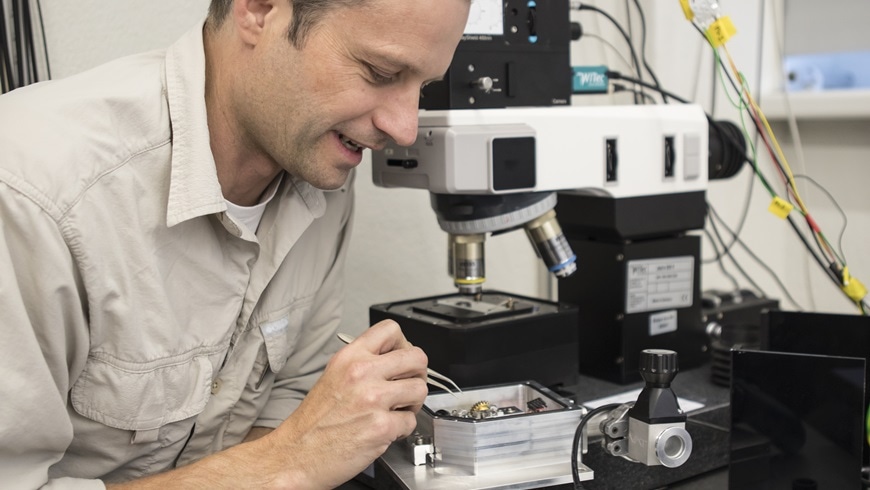Jan 21 2019
Normally, molecules are produced in laboratory flasks or reaction vessels. A group of researchers from Empa has now successfully produced molecules between two microscopically small, movable gold tips, apparently as a “hand-knitted” unique specimen.
 Michael Calame heads Empa’s “Transport at Nanoscale Interfaces” laboratory. He designed and supervised the experiments together with Marcel Mayor from the University of Basel and Jaime Ferrer from the University of Oviedo (Spain). (Image credit: Empa)
Michael Calame heads Empa’s “Transport at Nanoscale Interfaces” laboratory. He designed and supervised the experiments together with Marcel Mayor from the University of Basel and Jaime Ferrer from the University of Oviedo (Spain). (Image credit: Empa)
As the molecules are being produced, their properties can be monitored in real time. The results of the study have been reported in Nature Communications.
The production of electronic components usually conforms to a top-down pathway in sophisticated physical laboratories. Researchers are able to fabricate structures with the size not more than a few nanometers with the help of special carving tools in clean rooms. Yet, atomic precision has remained highly difficult to achieve and usually needs special microscopes such as a Scanning Tunneling Microscope (STM) or an Atomic Force Microscope (AFM). In contrast, chemists regularly achieve a tour de force: They can produce huge numbers of molecules that precisely look the same. However, producing a single molecule with atomic precision and observing this assembly process is still a difficult challenge.
A group of researchers from Empa, the University of Basel, and the University of Oviedo has now been successful in accomplishing that: The scientists produced chain-shaped molecules between two microscopically small gold tips. Each molecule is synthesized separately. It is possible to monitor and document the properties of the resulting molecule as it is synthesized.
Micro-Manufactory Between Gold Tips
Anton Vladyka, Jan Overbeck, and Mickael Perrin work at Empa’s “Transport at Nanoscale Interfaces” laboratory, led by Michel Calame. They used a technique known as mechanically controllable break junction (MCBJ) for their experiments. A gold bridge with a thickness of just a few nanometers is gradually stretched in a reagent solution till it breaks. Individual molecules can bind themselves to the nano-bridge’s fracture tips and go through chemical reactions.
Empa researchers immersed the gold tips in a solution of 1,4-diisocyanobenzene (DICB), a molecule that has strong electrical dipoles at both ends. The highly charged ends readily attach to gold atoms. As a result, once the bridge is torn apart, a DICB molecule separates individual gold atoms from the contact and consequently builds a molecular chain. A gold atom follows each DICB molecule, a DICB molecule follows the gold atom, and another gold atom follows the, and this chain repeats again and again.
High Success Rate
The thing to be noted is that the molecular assembly was independent of any coincidences, but worked in a highly reproducible way even at room temperature. The scientists opened and closed the gold bridge again and again to gain better insights into the process. Out of 100 trials, 99 identical molecular chains of gold and DICB were formed. The scientists were even able to determine the length of the chain by monitoring the electrical conductivity between the gold contacts. Up to three chain links could be detected. In case four or more chain links are created, the conductivity is very low and the molecule remains invisible during this experiment.
Basis for Chemical and Physical Analyses
This new technique enables scientists to synthesize electrically conductive molecules as unique specimens and to characterize them using a range of techniques. This paves way for completely new opportunities to alter the electrical properties of individual molecules directly (“in situ”) and to adjust them with atomic precision. This is regarded as an important step toward further miniaturization of electronic components. Simultaneously, it provides a deep understanding of the transport processes at the atomic level.
In order to discover new properties in molecular assemblies, we must first be able to build these molecular structures in a reproducible manner. This is exactly what we have now achieved.
Michel Calame, Head, Transport at Nanoscale Interfaces Laboratory, Empa